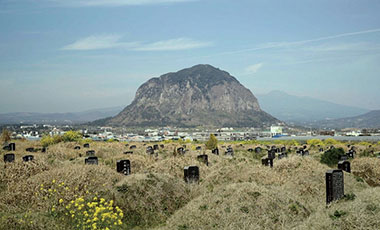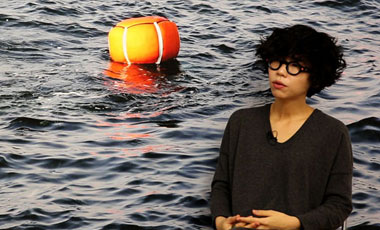People / Interview
Para/site Director Cosmin Costinas & TEOR/eTica Associate Director Inti Guerrero
posted 19 Nov 2013"This Westem-dominated modernity discourse has to change. And it will change. It's understandable why it happened because obviously the model of society, in many ways the mist accomplished model, was created in the West, in the post-war West. That's the prevailing model, which has prevented the good aspects of the non-Western World from moving into the foreground. We are still in the process of watching the death of this modemity and recreation of a new one. In a way it's a bit late. And obviously the narratives and the culture around it are catching up."
-

- Cosmin Costinas/ Director, Para/site (Hong Kong) Originally from Romania, Cosmin Costinas is director of Para/site in Hong Kong. His previous titles have included curator of BAK in the Netherlands, co-director of the 2010 Ural Industrial Biennial of Contemporary Art, and editor of the magazine documenta 12. Major exhibitions include Taiping Tianguo: A History of Possible Encounters: Ai Weiwei, Frog King Kwok, Tehching Hsieh, and Martin Wong in New York for Para/site (2012), Spacecraft Icarus 13. Narratives of Progress from Elsewhere and In the middle of things for BAK (2011), and I, the Undersigned, a touring exhibition at the Institute of International Visual Arts in London, the Lunds Konsthall in Lund, tranzit+display in Prague, and Württembergischer Kunstverein in Stuttgart (2010--2011).
-
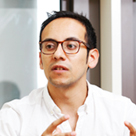
- Inti Guerrero/ Associate Director, TEOR/éTica (Costa Rica) A native of Colombia, Inti Guerrero is guest director for TEOR/éTica, a non-profit institution in Costa Rica. In addition to serving as resident curator for the Collection Fondazione Sandretto Re Rebaudengo in Turin and curatorial fellow at the De Appel’s Curatorial Programme in the Netherlands, he has also contributed to various European and South American art journals, including Afterall, Ramona, Art Nexus, and Arteria. Major exhibitions include Men Amongst the Ruins for TEOR/éTica (2013), Kadist. Pathways into a Collection for Minsheng Art Museum (2012), and The City of the Naked Man for the Museu de Arte Moderna de São Paulo (2010).
 From L: Kim Hyun-jin, Inti Guerrero, and Cosmin Costinas
From L: Kim Hyun-jin, Inti Guerrero, and Cosmin Costinas
Kim Hyun-jin : My first question is for Cosmin Costinas. Para/site, the place where you work as director, is involved in a lot of different types of exchange with Seoul. It’s small scale, but also autonomous in its operation, and I also think it’s a major art platform in Hong Kong, a place that has been leading the way in discourse-oriented international exchange and international openness for Hong Kong and the Asia region. From your experience at European and Asian art institutions, what kind of differences do you see in their exhibition planning environments and systems?
Cosmin Costinas : There are many differences. I’d start by saying that Europe has a greater variety of methods with its institutions than Asia does. For example, BAK [basis voor actuele kunst in Utrecht, Netherlands], where I worked, was an idiosyncratic institution in many ways. It runs a very flexible program without any kind of bureaucratic involvement, irrespective of the audiences, and irrespective of determinations of many other sorts.
It's different in the case of Para/site, primarily because there's some sort of responsibility towards the institution and to its history. It's an institution that cannot belong to a director, that cannot live or die with the will of a director. That being said, this is also very healthy for the institution.
There's clearly not a tradition of governmental institutional structure in Hong Kong, in the art scene. So there are almost none of the kinds of noncommercial spaces where you always have to view things in relation to the ecology of where it's located. But perhaps it even makes more sense to have a place like Para/site in Hongkong, which is super-highly commercial. So a little hub, surrounded by a clear commercial landscape, can become what one could think of as countercultural in the culture where it's located. That's what I think it is as an institution. An institution doesn't always have the same meaning within a society, but perhaps now Para/site has a more powerful meaning.
Kim Hyun-jin : Right now, you see large art museums like M+ in Hong Kong that are being developed from the outside as having a relationship with the global art environment. Are you at all worried that Para/site’s significance or role will end up diminished, or that there will be some change in its vanguard status?
Cosmin Costinas : We have lot of colleagues supporting Para/site in Hong Kong. And hopefully, it will continue being an important part of the art scene in the future. Obviously, M+ has incomparably stronger resources than Para/site. But I would like to make the point that it actually has very limited resources. I think Para/site has a role in terms of creating discussions within the city, discourse, providing curatorial models and artistic production, that is unparalleled by any other institutions in the city at the moment. In terms of support, I would say that definitely the Hong Kong government does care about the missions of supporting and building the contemporary art scene, but it has also shown a lack of support for alternative compositions. So that's a fact. I guess it's even more ironic that an institution like Parasite cannot rely on this support because of its sense of responsibility, its sense of doing things not just for the sake of the program, but for the sake of developing different components of the scene. [Note: Para/site recently lost a large part of the support it received from the Hong Kong government.] The program that we're doing -- this is usually the mission of a public institution, of a fully public institution. So it's ironic that we have to do it and at the same time rely on private support.
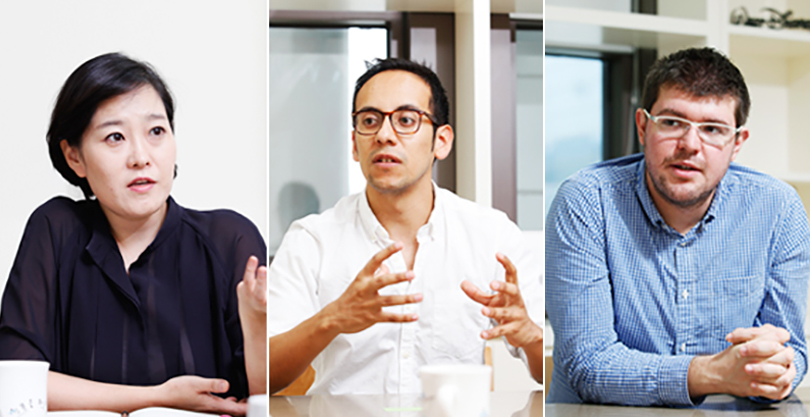
Kim Hyun-jin : The next question is for Inti Guerrero. I understand that you have been traveling back and forth between Hong Kong and San José as guest director for an institution in Costa Rica. South Korea remains quite out of touch with Central America, and there is not a lot of interchange happening on the ground in terms of culture. I guess I first would like to hear a bit about your institution, TEOR/éTica, and about your approach or perspective with regard to the region.
Inti Guerrero : TEOR/éTica emerged as a platform that responds to different landscapes in context. One of them is the immediate geo-political historical context. It was founded in 1999, and the late 1990s was a time when a regionalist geopolitical identity was taking shape in Costa Rica. In terms of historical context, the various civil wars in Central America stirred up a kind of tension between communism and warfare that was being supported by the CIA for [the U.S.‘s] own economic interests. And all of these very complex wars in different locations in Central America finally came to an end in the 1990s. Costa Rica, where TEOR/éTica is located, became the peacekeeper of those peace treaties. It became the neutral country that actually managed to create a stable region. That's the context where a contemporary art space, an institution, can have the credentials to consider contemporary art production and contemporary thought from one specific place in a vast region like Central America. Our ideals and experiments are a matter of initiating internationalism from the local, which is a different thing from global cosmopolitanism. It’s important that we start with exchange at the level of a highly specific region, and work to build networks of human experience where that cultural exchange develops a broader global resonance.
There were many exhibitions that started to map the idea of Latin American contemporary art. And there were many exhibitions that were survey exhibitions, traveling to different institutions outside. But none of these exhibitions succeeded in showing an understanding of just what contemporary Latin American art is. In most of the cases, the in-existence, the invisibility of Central America was always something that happened. It was never an artist from El Salvador or Costa Rica. So all these regions from the south of Mexico to Colombia just weren't part of Latin American discourse. TEOR/éTica wants to respond to this invisibility -- more than just wanting artists for exhibitions, it wants to imagine an international network, but from San Jose, where we’re introducing a lot of Central American artists and bringing in officials to visit TEOR/éTica. For ten years, it has been making a name for itself as the Central American institution that is most experimental and most advanced, in the sense of articulating not only the exposure of art, but the production of thought. Even the name of the institution is a mixture of different words -- phonetically, TEOR/éTica refers to “theory” in Spanish -- teoria -- and ética in Spanish refers to “ethics.”
Kim Hyun-jin : The two of you are from Europe and Central America. I’m curious what brought you to Hong Kong. And I’d like to know what you think about the contemporary art environment in Hong Kong from a curatorial perspective.
Cosmin Costinas : My coming to Hong Kong was more accidental than anything. I don't know if there is necessarily a specific answer to why I’m in Asia, but there's definitely an answer to why I don’t live in Europe. I think it has to do with trying to understand the world and look at the world in all its geographical and cultural complexity, and avoiding viewing the world from the hegemonic perspective of the North Atlantic point of view -- because honestly, I did not come from that hegemonic construction. I came from Romania, grew up in Romania, and I pretty much started to work in the international curatorial field from this position of outside. I don’t mean this in any sense of being “victimized.” But this is the position carved out for me, both my peers and by my kind of counterparts in the international system. So that's a position that often has lot of privilege. It's not necessarily a subordinate position. It's just a condition. The reason I bring it up is that growing up in that field, I never took for granted the internationality of my position or my perspective. In some sense, my coming to Asia springs from a kind of impulse or attempt to go to the last concert. It's by far the most influential part of the world that is not structurally within the West. And there's enough power here to shift the hegemonic discourse effectively. So I guess that's why I came to Asia. Especially, when you look at Europe, there's disbelief, there's lamenting about the state of things, there's this general malaise in society, a sense of economic and social crisis that is very much reflected in culture and especially in the art. It's almost the opposite in Asia. There's this general sentiment of growth, of optimism, of the potential of tomorrow. Now, that's very much fabricated by the system, by the economic system. But there can be potential for thriving in this kind of optimism and in illusions sometimes.
Inti Guerrero : From my understanding, I’ll start with the question of if I'm acting “international” enough. There's a kind of dangerous reconciliatory aspect of difference. This could be the result of the kinds of showcases for thinking that emerge from different areas -- the biennials, for example. And I think that as I do exhibitions around the world, each time there's some effort to try to make sense of why am I doing it at this place. The kind of curatorship I did come with an international specificity that originates in local history, where I’m actually trying to see more in depth and focusing on specific local experiences that can make you think of other situations. Hong Kong is an interesting place to think about the world, as a global city where you can take in a range of political experiences. So I’m thinking specifically about Hong Kong rather than some generalized “Asia.”

Kim Hyun-jin : I’d like to talk about A Journal of the Plague Year, the Para/site exhibition you planned together. You could call it a kind of dedication to Hong Kong, focusing on the disease that erupted there around the time of the SARS epidemic, and the symbolic symptom of other-exclusion.
Cosmin Costinas : Because of the way we both work in general, and because of the way Para/site's program imagined it, the idea of looking at the contemporary history of Hong Kong and the general cultural environment in which we operate had been defined from the beginning. In the beginning, it was all about approaching things with the tools of the historian, trying to see key moments and key stories within this reality that define Hong Kong's structure in this particular year, 2003. One of the unspoken premises of the show was that we were looking at 2003 as being almost in parallel with 1997, the year when Hong Kong was handed over to mainland China. So this was the moment when the actual first consequences of the handover were contested within the territory. And in parallel with the SARS crisis, there was this very striking moment, the suicide of Leslie Cheung, the pop idol. The title we gave the exhibition was A Journal of the Plague Year: Fear, Ghosts, Rebels, SARS, Leslie and the Hong Kong Story. There are several reasons why we chose this title, but probably the most important one was because it brought into it a certain kind of methodology, that of the journal. The structure of a journal is a list of occurrences, of events that share or have in common primarily their simultaneity, their occurrence in a given time frame. And our proposition is that these two events potentiate each other. The specter of absolute doom with SARS was enhanced by Leslie's very theatrical death at that particular moment. Besides these sets of consequences, we also tried to look at the historical background of this event, especially as connected to disease, discrimination and exclusion, and this fear of infection, fear of contamination, fear of the other, and fear of racial and cultural contamination. A very important event in Hong Kong, and in world history, was the plague of 1894. It was actually learned in 1994 that the epicenter of this plague, which killed so many people in Europe and elsewhere, was a village in the old Chinese port, right near where Para/site is today. It made the international news, and it was instinctively connected to a fear of Asians and a paranoia against the Asians -- what is now known as the “Yellow Peril.” This was pretty much the biggest fear in Western civilization at the end of 19th century and early 20th century up until WWI -- a sense of existential threat coming from Asia. It was represented in different ways, but in particular there was a fear of the Japanese, imperialism and the rising power of Japan, or a fear of the Chinese because of their sheer numbers. It was a symptom that was latent in, and strengthened by, the discovery of this disease in Hong Kong. So the combination of disease and plague on one hand and fear of the other on the other was presented as the story of Hong Kong, and these were the very general parameters of the exhibition.
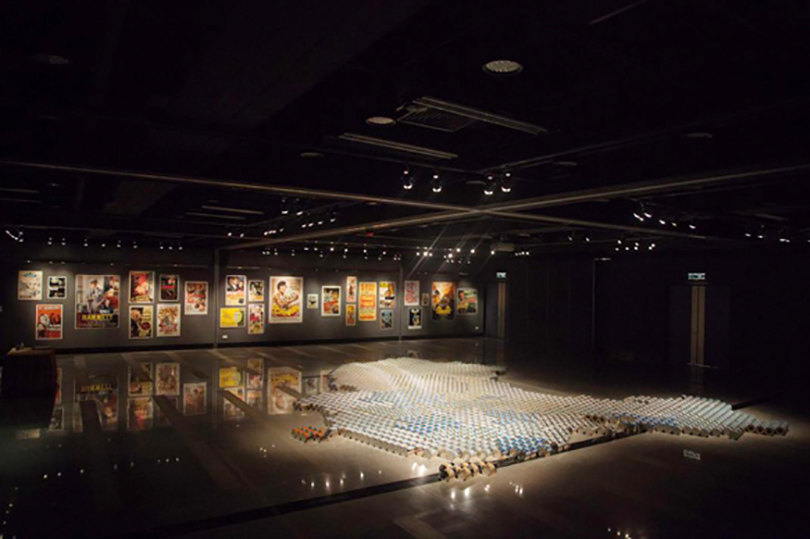 Installation for A Journal of the Plague Year
Installation for A Journal of the Plague Year
Kim Hyun-jin : While modern and postmodern discourse originally took shape around first world, Western society, nowadays it’s shifting outside of the first world. Your exhibition seems to adopt a methodology of starting from this kind of global modernity and observing different forms of regionality to produce a richer discourse.
Cosmin Costinas : That’s true. This Western-dominated modernity discourse has to change. And it will change. It's understandable why it happened -- because obviously the model of society, in many ways the most accomplished model, was created in the West, in the post-war West. That’s the prevailing model, which has prevented the good aspects of the non-Western world from moving into the foreground. We are still in the process of watching the death of this modernity and recreation of a new one. In a way it's a bit late. And obviously the narratives and the culture around it are catching up.
Inti Guerrero : When I think about your question about modernity, I remember something said by David Teh, a curator in Singapore. He was trying to see how the subject, the idea of contemporaneity in art, came out of the simultaneous emergence of differences. But he said, for example, with the idea that contemporality emerged from the experience of conceptualism in the '60s, that the idea of “being in the contemporary” was what led to the emergence of curators. There were many institutions where you could see that the context was trying to dig into the history of where the conceptualism started. Perhaps the contemporary does not necessarily have to begin through conceptualism. For example, coming back to our exhibition, we said that one of the interesting aspects in terms of understanding contemporaneity was understanding what had happened in the 19th century, with the plague, and drawing parallels with all these racist representations that started to happen in Europe and in America. This is my personal thing, but I prefer to think about these kinds of references solely in the context of art history.
Kim Hyun-jin : I agree with what you said. It’s undeniable that the first world is where modern and postmodern discourse first emerged, and it was the first world that spearheaded its deconstruction. But the situation now is one where Western society is powerfully influenced by the emerging third world market, and its supremacy is starting to slip. In the process, the framework of cultural appropriation is becoming more complex, as their linear social model is being related to or incorporated into third world social structures. What we need to do now is to achieve a new kind of horizontal enrichment, considering and executing ways of shaping the global into complex, interesting, subversive narratives using the phenomena, perspectives, and potential of wherever we happen to be. What I heard from you today seemed to describe a true form of curatorial practice from that kind of clear perspective.

Kim Hyun-jin / Chief Curator, Ilmin Museum of Art
Kim Hyun-jin is chief curator at the Ilmin Museum of Art in Seoul. Since 1999, she has worked as an assistant curator at numerous venues, including Alternative Space Loop, Ssamzie Space, and Artsonje Center. From this experience, she went on to serve stints as an invited or guest curator at Van Abbemuseum in the Netherlands, IASmedia, and Kaywon School of Art and Design’s Gallery 27. She worked as curatorial assistant for the 2005 Istanbul Biennial and co-curator for the 2008 Gwangju Biennale. Major exhibitions include Brilliant Collaborators for Ilmin Museum of Art in Seoul (2013), Playtime -- The Waiting Room of Episteme for Culture Station Seoul 284 (2012), Perspective Strikes Back for Doosan Gallery Seoul (2009) and L’Appartement22 in Rabat (2010), Accidental Community and Ten Years, Please: A Jewyo Rhii Project for Gallery 27 in Uiwang (2007), 30 Sa-dong: Yang Haegue in Incheon (2007), and Plug-in #3: The Undeclared Crowd at Van Abbemuseum in Eindhoven (2006). She has also contributed to, edited, and published a number of exhibition books, including The Speed of the Large, the Small, and the Wide: Chung Seoyoung Solo Exhibition (Hyunsil, Seoul, 2012), Inter-views (Bigaku Shuppan, Tokyo, 2011), Gao Shiqiang: The Other There (Timezone8, Beijing, 2009), Jewyo Rhii (Samuso/Dareun Books, Seoul, 2008), 30 Sa-dong: Yang Haegue (Wien Verlag, Berlin, 2007), and Dolores Zinny and Juan Maidagan (Sala Rekade, Bilbao, 2007).

